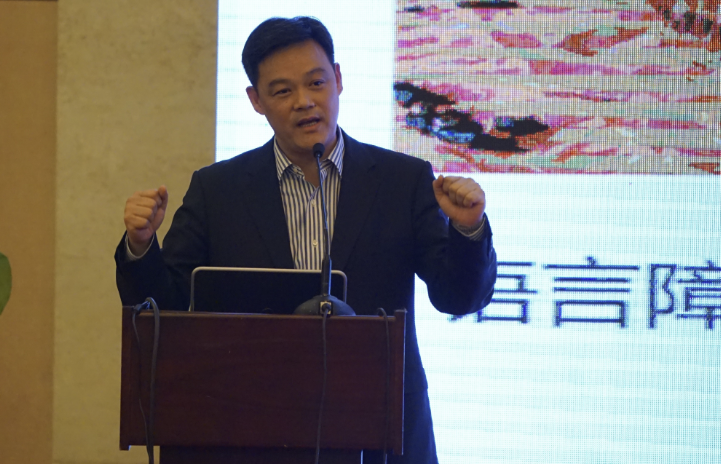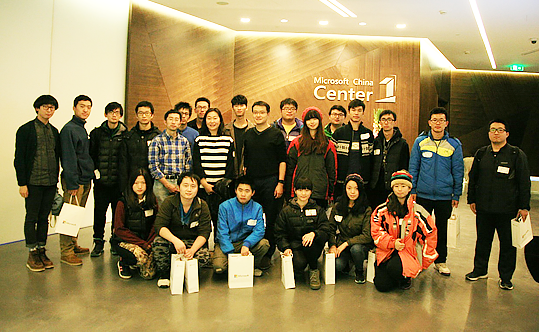By Bei Li, Research Program Manager, Microsoft Research
“The current development of computer science resembles the Renaissance in Italy of the 15th century,” said Tim Pan, director of Microsoft Research Asia, during a keynote speech on “Interdisciplinary Effect” at the 11th Forum on College Computer Curricula in Tianjin, China. Organized by the Chinese Ministry of Education, the forum, held on November 28, 2015, drew more than one thousand educators from 700 local colleges. Attendees shared their experiences and explored new ideas for computer science education.
 (opens in new tab)Tim Pan addresses computer science educators at the 11th Forum on College Computer Curricula.
(opens in new tab)Tim Pan addresses computer science educators at the 11th Forum on College Computer Curricula.
Microsoft research podcast
Pan believes that interdisciplinary development will enable unprecedented vitality in computer science. This is based on what Jeannette Wing, corporate vice president of Microsoft Research, has called “computational thinking”. Computational thinking uses basic concepts in computer sciences to solve problems, design systems, and understand human behaviors. It covers the breadth of computer science and beyond, stimulating comprehensive and far-reaching impact on industries around the world. In some cases, these developments even disrupt long-held research findings and business models. This upheaval has elevated the importance of fundamental computer education in colleges, where reforms are urgently needed.
Microsoft launched the Industry-Academia Cooperation Comprehensive Reform Program in China in 2014, aiming to introduce computational thinking classes into the basic computer curriculum for college students. The program accepts proposals from all Chinese institutions of higher learning. Qualified submissions are eligible for financial support and receive free Microsoft cloud services. The program has been warmly received by college faculties nationwide; 99 proposals were submitted before the end of Phase I in December, 2015. Twenty-one of those, covering a variety of disciplines, qualified for Microsoft privileges. Following are two examples of computational thinking curriculum.
Learn in play: bilingual teaching in computer science for hearing-impaired students
Perhaps the most unusual course selected for Phase I was the “Art of Computational Thinking”, proposed by Hanjing Li from the School of Special Education at Beijing Union University. In the course, which served more than one hundred hearing-impaired juniors majoring in computer science, Li and her colleague, Liu Hui, lectured in both spoken and sign languages.
With computational thinking at its core, the course used subtitles and gaming scenes to help hearing-impaired students understand computer concepts. The final assessment was also conducted in both spoken and sign language. The first class of students completed this course with flying colors, and 5 of their course projects won honors in the university’s computer application contest.
 (opens in new tab)Hearing-impaired computer science students from Beijing Union University visited Microsoft headquarters in Beijing.
(opens in new tab)Hearing-impaired computer science students from Beijing Union University visited Microsoft headquarters in Beijing.
Individualized education: pioneering “MOOC+SPOC” mode
“College Computer Fundamentals” is a compulsory course for non-computer science students in all Chinese colleges. It’s intended to improve students’ information-related skills and familiarize them with the fast pace of a high-tech society. Unfortunately, students have described the course as “boring, uninteresting, and unrelated to future occupations.” This isn’t surprising, as teachers often attempt to cover as many computer skills as possible within limited class hours, turning their lectures into “window-shopping” sessions.
Reforming the required course was imperative. And, with support from Microsoft Research Asia, Professor Dechen Zhan from the Harbin Institute of Technology took the lead. Zhan tested changes in his own classroom and simultaneously launched a “MOOC Coalition”, providing massive open online courses (MOOCs) for college computer curricula. 50,000 students enrolled as soon as the first batch of the reformed MOOCs were available. Students responded enthusiastically, with 150,000 student discussions recorded during these courses. Dechen then added small private online classes (SPOCs), in which normal-sized college classrooms could access online curricula. This innovative MOOC+SPOC approach has inspired a number of hybrid reforms in teaching practices. New courses have attracted 21,000 students from 13 colleges and universities nationwide.
In March, 2016, Microsoft Research Asia will become the first Asian research institute in the history of SIGCSE (the Association for Computing Machinery’s Special Interest Group on Computer Science Education, the world’s top forum on computer science education) to chair a themed discussion. Entitled “Computational Thinking: a China Perspective,” the discussion will bring together computer science educators from around the world to review the outcomes and challenges of the Industry-Academia Cooperation Comprehensive Reform Program, and to explore the role of computational thinking and reforms in computer education.
Microsoft Research Asia will continue to work with international scholars to explore new ideas and overcome challenges. This collaboration aims to enable first-class computer education for students around the globe, promoting development in computer science and related disciplines.
Learn More





